7 Best Platforms for Remote Jobs for Digital Nomads in 2025
Max
The dream of working from anywhere, whether a sun-drenched beach in Bali, a bustling cafe in Lisbon, or a quiet mountain retreat, is more attainable than ever. The key lies in finding the right opportunities. However, the online job market is vast and often cluttered, making it difficult to distinguish legitimate, high-quality remote positions from scams or location-restricted roles. This guide cuts through the noise.
We’ve curated the definitive list of the best platforms for finding remote jobs for digital nomads in 2025. Each platform has been evaluated for its quality of listings, user experience, and focus on true location-independent roles, providing you with a clear roadmap to kickstart or advance your nomadic career. As you plan your journey, it’s also crucial to consider practicalities beyond just employment, such as securing adequate health insurance specifically designed for digital nomads.
This article will explore what makes each job board unique, the types of roles you can expect, and how to leverage their features to land your next great adventure. For every platform, we provide a detailed overview, screenshots, and direct links to help you start your search immediately.
1. Remote First Jobs
Remote First Jobs establishes itself as a premier destination for professionals seeking genuine, fully remote career opportunities. It’s an essential resource for digital nomads who require roles that aren’t just “remote-friendly” but are built around a remote-first company culture. This platform distinguishes itself by aggregating high-quality, verified listings directly from company career pages, ensuring every job is legitimate and actively hiring.
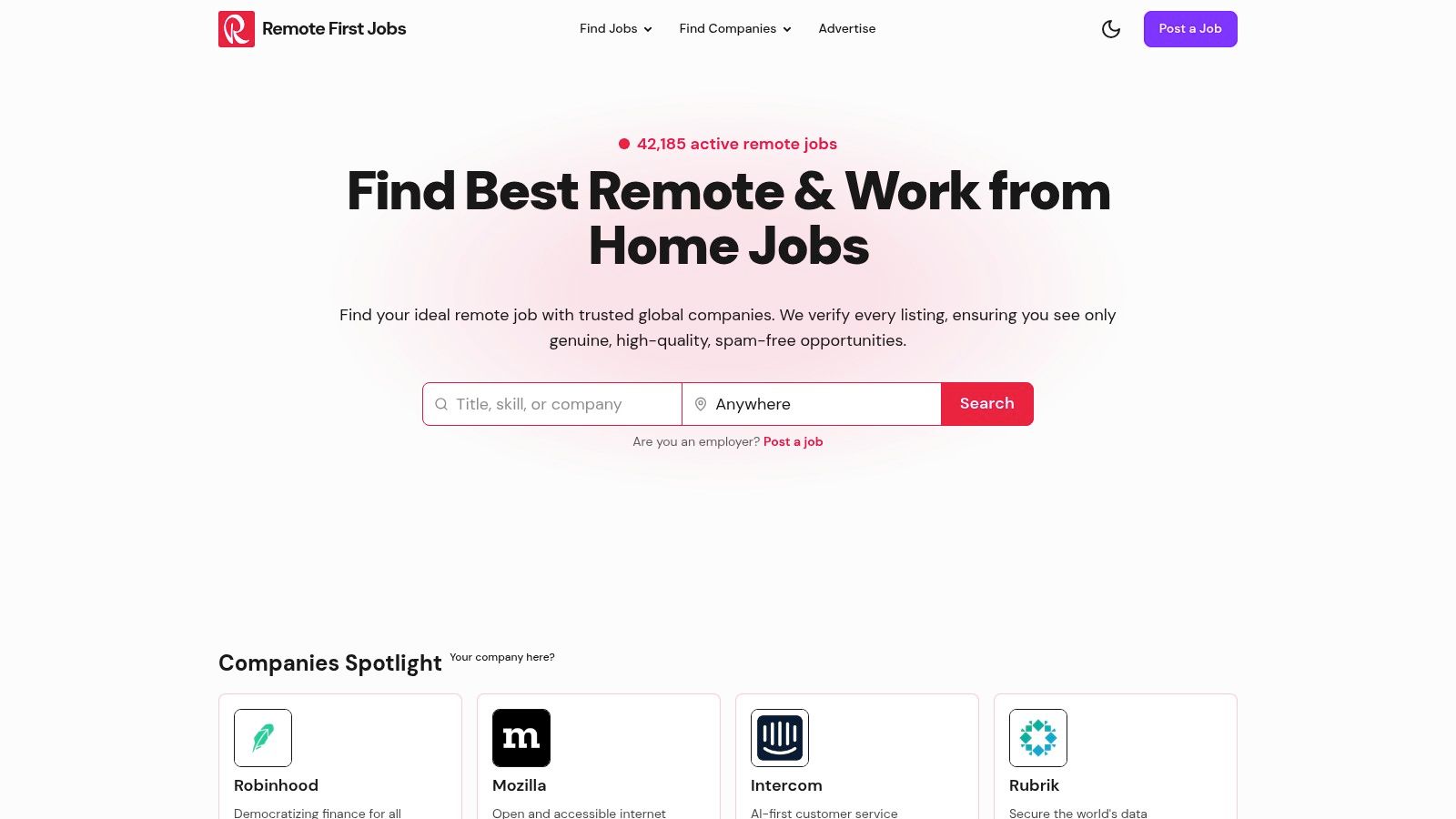
The core strength of Remote First Jobs lies in its commitment to quality over quantity. By meticulously scanning over 20,000 company sites daily, the platform maintains a fresh, spam-free database of over 40,000 active roles from more than 21,000 trusted companies. This approach provides access to exclusive listings that often don’t appear on larger, more conventional job boards, giving users a competitive edge in their search for the perfect remote job for digital nomads.
Standout Features and Practical Use
The platform’s design prioritizes a powerful, user-centric experience. Job seekers can move beyond simple keyword searches and utilize a sophisticated filtering system to pinpoint opportunities with precision. This allows for a highly customized job hunt, which is invaluable for nomads with specific needs.
- Advanced Search Capabilities: Filter jobs by skill, industry sector, specific benefits (like a 4-day work week), seniority level, and even company location if you need to align with certain time zones.
- Verified Remote-First Culture: Every company listed is vetted for its commitment to remote work. This provides peace of mind that you’re applying to organizations that understand and support a distributed workforce. To better understand this concept, you can learn more about what remote-first means directly on their blog.
- Streamlined User Experience: The interface is clean and intuitive, making it easy to browse, save jobs, and apply. There are no intrusive ads or distracting pop-ups, allowing for a focused job search.
- Rich Content and Resources: Beyond job listings, the site offers a blog with insightful articles and productivity tips tailored to the remote professional, helping candidates excel in their roles.
How to Get the Most Out of Remote First Jobs
To maximize your success, leverage the platform’s advanced tools. Set up daily or weekly alerts for specific keywords and filter combinations that match your ideal role. When you find a promising opening, take note of the company and explore its profile and other available jobs. This can provide valuable insights into its culture and the types of roles it frequently hires for. The platform is completely free for job seekers, with no hidden fees or access restrictions. For employers, posting jobs is straightforward, offering enhanced visibility through featured placements and social media promotion.
2. FlexJobs
FlexJobs has established itself as a premier destination for finding high-quality, flexible work, making it an indispensable resource for those seeking remote jobs for digital nomads. Unlike general job boards that simply aggregate listings, FlexJobs employs a human-led screening process. Every single job is hand-screened to ensure it’s a legitimate, professional opportunity, which significantly reduces the risk of encountering scams or low-quality offers.
This platform caters specifically to remote, hybrid, freelance, and flexible schedule jobs across more than 50 career categories. The user experience is clean and intuitive, allowing you to filter opportunities by job type, career level, and crucially for nomads, location requirements. You can specify “work-from-anywhere” to find roles with true global flexibility.
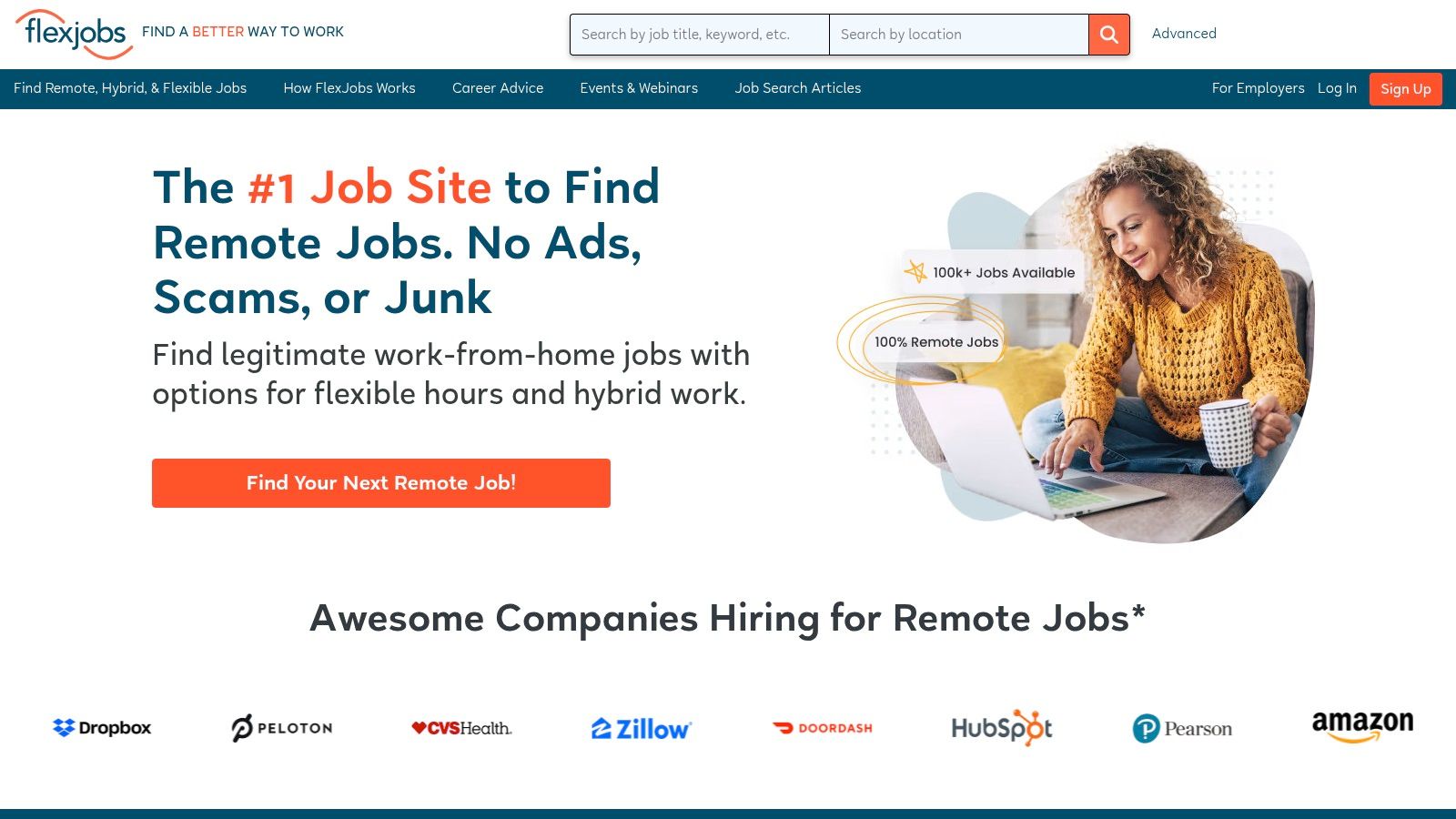
Why FlexJobs Stands Out
The key differentiator for FlexJobs is its commitment to quality over quantity. The subscription model, while a potential drawback for some, funds the research team that vets every posting. This paywall creates a more serious and professional environment for both job seekers and employers.
Subscribers gain access to a suite of tools beyond the job listings. These include skills tests, expert resume reviews, and career coaching sessions. FlexJobs also publishes valuable research, like its annual “Top 100 Companies to Watch for Remote Jobs,” giving you a strategic advantage in your job search.
Pros and Cons of Using FlexJobs
| Pros | Cons |
|---|---|
| Human-Screened Listings: Scam-free guarantee. | Subscription Fee: Requires payment for full access. |
| High-Quality Opportunities: Professional roles. | Location Limits: Not all jobs are work-from-anywhere. |
| Excellent Search Filters: Pinpoint nomad jobs. | Competition: Popular platform means more applicants. |
| Valuable Member Resources: Career coaching, etc. |
Getting the Most Out of FlexJobs
To maximize your success, take full advantage of your membership. Create a detailed profile, upload multiple versions of your resume tailored to different roles, and set up daily job alerts for “work-from-anywhere” positions in your field. Also, be sure to explore the platform’s blog and webinars for tips on acing remote interviews and negotiating salaries. Exploring a wider range of jobs with flexibility can also provide valuable context for your search on the platform.
Website: https://www.flexjobs.com
3. We Work Remotely (WWR)
We Work Remotely (WWR) has positioned itself as one of the largest and most respected communities for finding and listing remote work. As a go-to resource for a vast number of companies, it’s a crucial platform for anyone searching for remote jobs for digital nomads. WWR focuses exclusively on remote opportunities, ensuring that every listing is intended for a location-independent professional, which saves valuable time for job seekers.
The platform is celebrated for its straightforward, no-frills interface, prioritizing function over flash. It neatly categorizes jobs into areas like Programming, Design, Product, Marketing, and Customer Support, making it easy to navigate. Job seekers can browse and apply to all listings for free, removing any financial barriers to accessing top-tier remote roles.
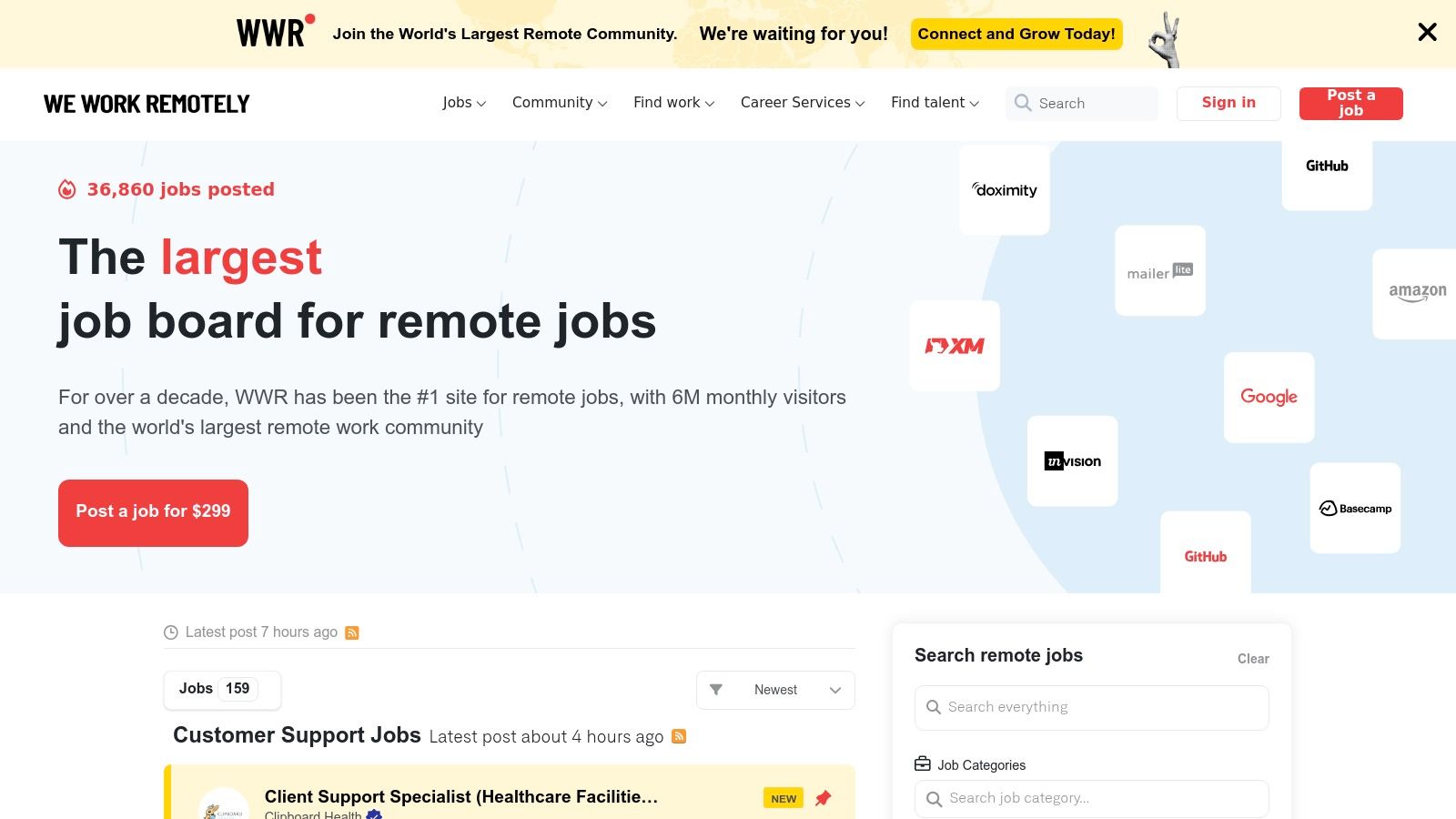
Why We Work Remotely Stands Out
WWR’s core strength lies in its simplicity and its massive, engaged audience, which attracts a high volume of quality job postings from both startups and established tech companies. Unlike many boards, it’s completely free for job seekers. The revenue model is based on employers paying a flat fee to post, which helps maintain a certain level of quality and seriousness among the listings.
The site also functions as more than just a job board; it’s a community hub. WWR offers resources, a popular newsletter, and a strong brand presence that instills confidence. This focus on remote-first culture has made it a trusted name in the industry, ensuring a consistent flow of fresh opportunities perfect for the nomadic lifestyle.
Pros and Cons of Using We Work Remotely
| Pros | Cons |
|---|---|
| Exclusively Remote: Every job is remote. | Location Restrictions: Some roles have time-zone limits. |
| Free for Job Seekers: No subscription needed. | High Competition: Its popularity attracts many applicants. |
| High Volume of Listings: New jobs posted daily. | No Vetting Service: Lacks the human screening of FlexJobs. |
| Simple, Clean Interface: Easy to navigate. | Limited Filters: Less advanced search options. |
Getting the Most Out of We Work Remotely
To stand out on WWR, regularly check the site for new listings, as the best roles can receive applications quickly. Sign up for their newsletter to get curated jobs sent directly to your inbox. Since the platform is straightforward, a strong, well-tailored resume and cover letter are paramount. Take time to research each company and customize your application to align with their remote culture and specific needs. Exploring a curated list of the best remote job websites can give you more context on how WWR compares to other leading platforms.
Website: https://weworkremotely.com
4. Remote OK
Remote OK has carved out a niche as a go-to job board for the tech-savvy professional, making it a powerful tool for those seeking remote jobs for digital nomads. The platform is known for its minimalist, tag-based interface and its strong focus on roles within startups and modern, distributed companies. It aggregates a vast number of remote positions daily, presenting them in a feed that is both comprehensive and easy to scan.
The site’s design prioritizes speed and efficiency. Candidates can immediately see crucial details like salary ranges, required skills, and location or time zone constraints through a clear system of tags. This allows digital nomads to quickly filter out irrelevant positions and focus only on opportunities that align with their skills and lifestyle, such as “worldwide” or “async” roles.
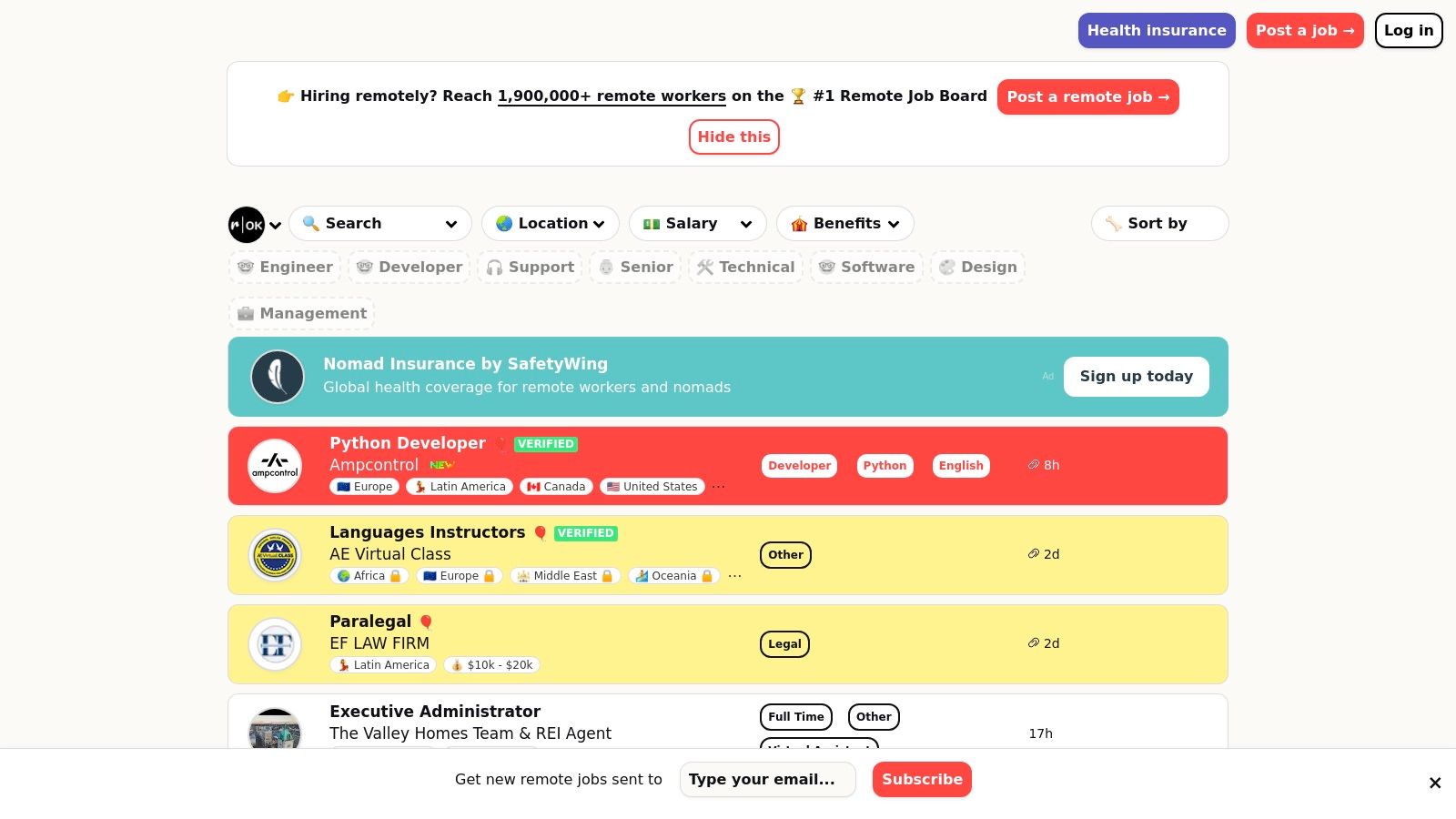
Why Remote OK Stands Out
Remote OK’s key differentiator is its transparent, data-driven approach and its deep integration with the startup and tech communities. Founded by a prominent digital nomad, the platform has an authentic understanding of what remote workers need. It’s completely free for job seekers, removing any barrier to access high-quality listings from innovative companies.
For employers, Remote OK offers premium posting options designed for maximum visibility, such as logo highlighting and pinned posts, which in turn attract a higher caliber of companies. This curated environment benefits job seekers by concentrating legitimate, well-paying tech and operations roles in one place, saving time and effort in the job hunt.
Pros and Cons of Using Remote OK
| Pros | Cons |
|---|---|
| High Visibility of Tech Roles: Strong focus on engineering, design, and marketing. | High Employer Costs: Premium features can be expensive for companies. |
| Free for Candidates: No subscription fee to apply. | Intense Competition: Popular roles attract a large number of applicants. |
| Excellent Tagging System: Quickly assess role eligibility. | Niche Focus: Less variety in non-tech or creative fields. |
| Transparent Salary Info: Many listings include salary ranges. |
Getting the Most Out of Remote OK
To maximize your chances, leverage the platform’s robust filtering system. Use a combination of tags like “worldwide,” your core skill (e.g., “React,” “Content Marketing”), and role type (“Full-Time”) to narrow your search. Set up alerts for these specific combinations to get notified of new opportunities instantly. Since competition is high, ensure your application is tailored to each role and highlights your experience with remote work and asynchronous communication.
Website: https://remoteok.com
5. Remotive
Remotive is a highly curated job board and community that has carved out a niche by focusing primarily on tech and startup roles, making it a go-to platform for finding high-quality remote jobs for digital nomads. It champions a straightforward, no-nonsense approach, presenting hand-picked job listings without the clutter of aggregator sites. This focus ensures that the opportunities are relevant and often from innovative, remote-first companies.
The platform is more than just a job board; it’s a community hub. Remotive offers a popular newsletter, a wealth of resources, and a vibrant private Slack community. For developers and power users, its public RSS feed and API are standout features, allowing them to monitor new job postings in real-time and gain a competitive edge in their applications.
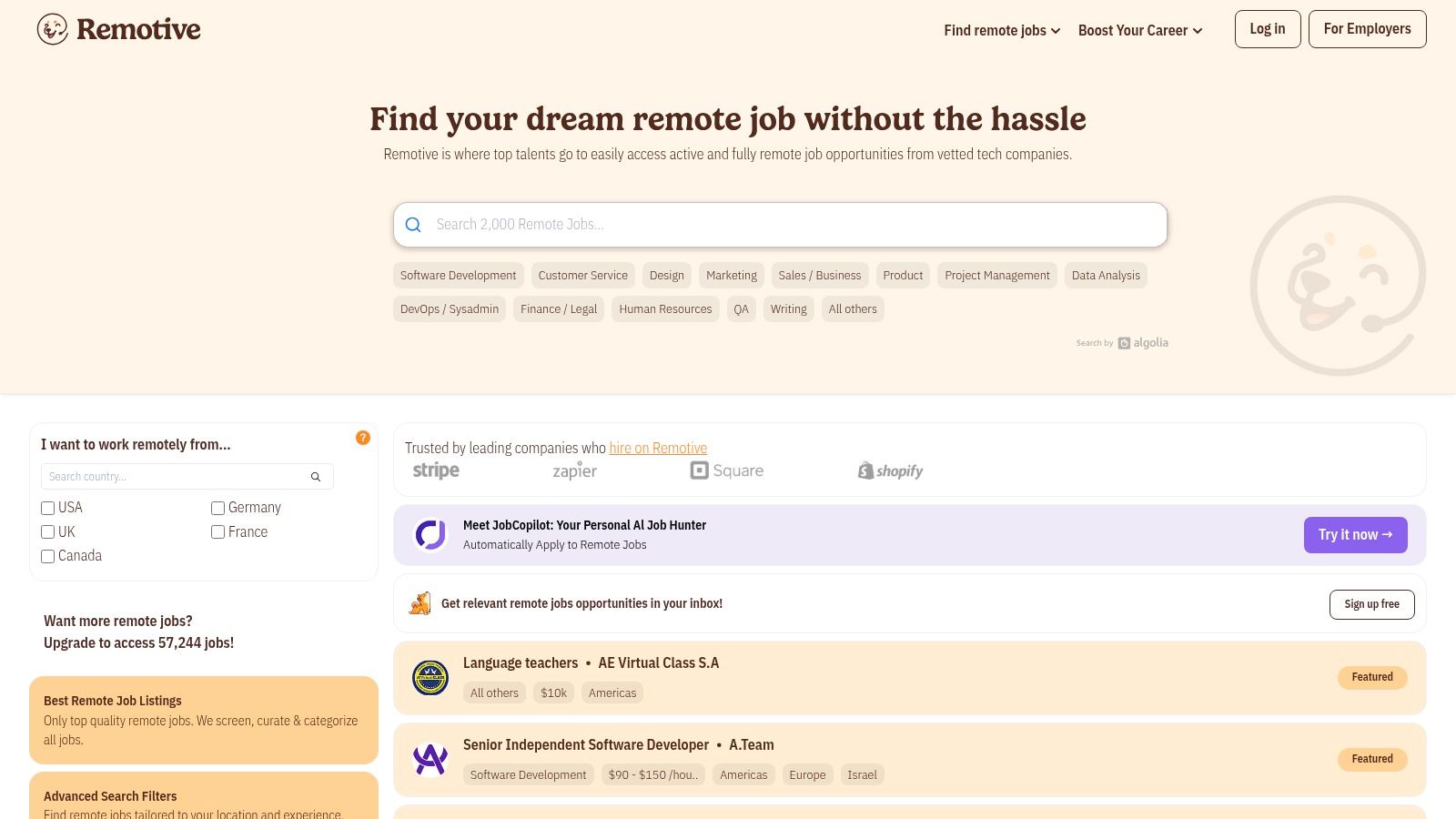
Why Remotive Stands Out
Remotive’s strength lies in its tight-knit community and its dedicated focus on the tech sector. Unlike massive job boards, its curation process filters for serious, high-quality remote positions, which is particularly beneficial for software developers, designers, and marketers. The platform’s optional “Remotive Accelerator” program is a unique offering, providing members with enhanced job-seeking features, direct support, and community access for a one-time fee.
This community-centric model provides a support system that many digital nomads find invaluable. Access to the Slack community connects you with fellow remote workers who share tips, leads, and encouragement, transforming the often-isolated job search into a more collaborative experience.
Pros and Cons of Using Remotive
| Pros | Cons |
|---|---|
| Curated Tech & Startup Jobs: High-quality roles. | Niche Focus: Fewer non-tech roles are available. |
| Strong Community Aspect: Access to a Slack group. | Paid Accelerator: Some key features require a fee. |
| Power-User Tools: Public API and RSS feeds. | Competitive Tech Roles: High demand for listed jobs. |
| Straightforward Interface: Easy to navigate. |
Getting the Most Out of Remotive
To maximize Remotive, subscribe to their newsletter to get curated jobs delivered directly to your inbox. If you’re technically inclined, leverage the API or RSS feed to create custom alerts for new postings that match your skills. For those serious about their job hunt, especially beginners, consider the Accelerator program for its added resources and community access. Exploring additional resources about the best remote jobs for beginners can also help you identify which roles on Remotive are the best fit for your skill set.
Website: https://remotive.com
6. LinkedIn Jobs
As the world’s largest professional network, LinkedIn has evolved into a powerhouse for discovering remote jobs for digital nomads. Beyond its social networking capabilities, its robust job board offers a massive, constantly updated marketplace of opportunities. The platform integrates your professional profile directly into the job search, allowing you to apply with a single click using “Easy Apply” for many listings.
LinkedIn Jobs allows for highly specific searches, with dedicated filters for “Remote,” “Hybrid,” and “On-site” roles. This functionality is crucial for nomads looking to weed out location-dependent positions. The platform’s strength lies in its ecosystem; you can research company pages, see who works there, and connect with hiring managers, all within the same environment.
Why LinkedIn Jobs Stands Out
LinkedIn’s primary differentiator is the seamless integration of professional networking with job hunting. You aren’t just applying to a role; you’re engaging with a professional community. This allows you to build connections, get referrals, and gain visibility with recruiters actively searching for candidates. The sheer volume of listings from a vast base of employers, from startups to Fortune 500 companies, is unmatched.
Furthermore, a free account provides powerful tools like granular job alerts and saved searches, ensuring you never miss a relevant opening. To further refine your job search strategy, understanding how modern recruiters source candidates can provide an invaluable edge on a platform like this.
Pros and Cons of Using LinkedIn Jobs
| Pros | Cons |
|---|---|
| Massive Employer Base: Unrivaled job volume. | Tagging Inconsistencies: Some “remote” jobs are mislabeled. |
| Strong Networking Tools: Connect with hirers. | Location Requirements: Many remote roles are state-specific. |
| Free Job Seeker Account: Powerful free tools. | High Competition: Popular roles receive many applications. |
| Integrated Professional Profile: Easy Apply. |
Getting the Most Out of LinkedIn Jobs
To succeed, ensure your profile is 100% complete and optimized with keywords relevant to your industry and desired remote roles. Turn on the “Open to Work” feature to signal your availability to recruiters. Set up precise daily job alerts for remote positions in your field, using negative keywords (e.g., “-office”) to filter out irrelevant listings. Engage with content from companies you admire to stay on their radar. For a deeper dive, explore detailed strategies on how to find remote jobs using the platform’s advanced features.
Website: https://www.linkedin.com/jobs
7. Indeed
As one of the world’s largest job aggregation sites, Indeed offers an immense volume of listings, making it a powerful tool for finding remote jobs for digital nomads, especially within the US market. While not exclusively a remote job board, its powerful search engine and extensive database mean that with the right filters, you can uncover a vast array of opportunities across nearly every industry and experience level, from entry-level to executive.
The platform’s strength lies in its sheer scale and familiar interface. Users can easily apply the “Remote” filter to narrow down results, though it’s crucial to read descriptions carefully as some may be hybrid or restricted to specific states. Indeed provides a straightforward search experience, aggregating roles from company career pages and other job boards into one central location.
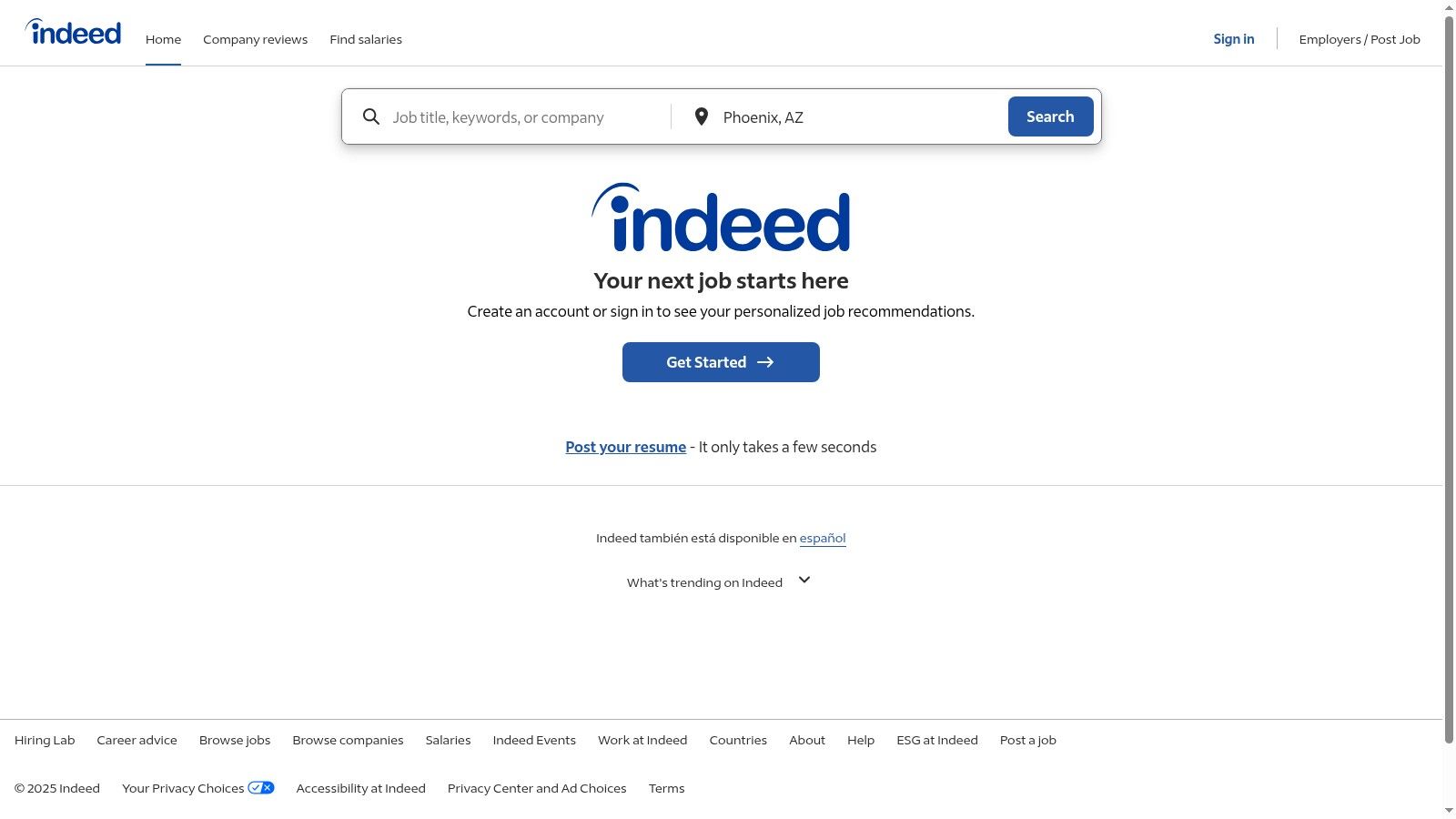
Why Indeed Stands Out
Indeed stands out due to its comprehensive coverage and free access model. Unlike niche platforms, it captures roles from a massive number of employers, including many that may not post on specialized remote-only boards. This makes it an excellent resource for finding remote positions in less common fields outside of the tech-centric bubble.
The platform also integrates valuable tools like company reviews and salary insights directly into the job listings. This allows you to research potential employers and gauge compensation standards without leaving the site. Its job safety guidance also helps users identify and report suspicious listings, adding a layer of security to the open-access model.
Pros and Cons of Using Indeed
| Pros | Cons |
|---|---|
| Massive Volume of Listings: Unmatched scale. | “Remote” Tag Ambiguity: Some jobs are hybrid or local. |
| Completely Free to Use: No subscription fees. | High Signal-to-Noise Ratio: Requires careful filtering. |
| Broad Industry Coverage: Excellent for non-tech. | High Applicant Volume: Can be extremely competitive. |
| Integrated Company Reviews: Research employers. |
Getting the Most Out of Indeed
To use Indeed effectively, master its search functionality. Use boolean search queries like "remote" AND "work from anywhere" in the keyword field, in addition to the location filter, to refine your results. Set up multiple job alerts for different keyword combinations to have relevant opportunities sent directly to your inbox. Always vet the job description to confirm the role is truly location-independent and not just remote within a specific city or country.
Website: https://www.indeed.com
Top 7 Remote Job Platforms Comparison
| Platform | Implementation Complexity 🔄 | Resource Requirements ⚡ | Expected Outcomes 📊 | Ideal Use Cases 💡 | Key Advantages ⭐ |
|---|---|---|---|---|---|
| Remote First Jobs | Moderate - advanced filters and employer tools | Moderate - needs daily updates and job verification | High - verified, spam-free remote-only listings | Professionals seeking fully remote jobs; employers wanting wide global remote talent | Extensive verified listings; intuitive search; employer promotion tools; productivity resources |
| FlexJobs | Moderate - curated, human-reviewed jobs | Moderate - human screening and member management | High - scam-reduced, flexible and remote roles | Users looking for vetted remote, hybrid, freelance roles with guidance | Scam-free, curated jobs; research and training; trial membership available |
| We Work Remotely (WWR) | Low - simple remote-only job board | Low to Moderate - employer-paid postings | Medium to High - frequent new remote listings | Job seekers wanting free access to remote jobs; employers targeting active remote audience | Free for job seekers; large, active marketplace; Google Jobs distribution |
| Remote OK | Moderate - tagging and filters; add-ons for employers | Moderate - employer bundles and promotion features | High - tech-focused roles with quick eligibility check | Candidates targeting startup and tech remote jobs; employers seeking visibility | Extensive filters; employer branding options; free candidate access |
| Remotive | Low to Moderate - tech/startup focus with public API | Low to Moderate - community and API tools | Medium - curated tech roles with job seeker community | Tech/startup job seekers wanting early access tools and community | Curated tech jobs; public API/RSS; community and accelerator program |
| LinkedIn Jobs | High - integrates networking, alerts, and messaging | High - requires professional network engagement | Very High - vast listings with networking and alerts | Professionals leveraging network for US remote and hybrid roles | Largest network; powerful filters and alerts; free seeker accounts |
| Indeed | Low - familiar job board with remote filters | Low - large site with broad employer base | High - extensive US coverage including hybrid roles | Broad job seekers across industries seeking remote/hybrid options | Widely known; free access; company reviews and salary insights |
Your Next Chapter Starts Here
The journey from dreaming about a location-independent lifestyle to living it is paved with preparation, strategy, and the right resources. Throughout this guide, we’ve explored the premier platforms for finding remote jobs for digital nomads, from the massive reach of generalist boards like LinkedIn and Indeed to the highly curated, niche communities of We Work Remotely and Remotive. Each tool offers a unique pathway to your next great adventure, but the key to success lies not in simply browsing, but in strategically leveraging these platforms to your advantage.
The core takeaway is that a one-size-fits-all approach no longer works. Your job search must be as dynamic and flexible as the lifestyle you seek. While quantity has its place, quality and alignment are what truly sustain a nomadic career. This means looking beyond the job title and salary to understand a company’s culture, its stance on asynchronous work, and its support for a globally distributed team.
From Aspiration to Action: Your Strategic Next Steps
To transform this information into a successful job offer, you need a clear action plan. Don’t just passively apply; actively build your presence and strategy around the platforms that best suit your career goals.
- Diversify Your Search, But Focus Your Effort: Create profiles on 2-3 platforms that align with your industry. A developer might focus on Remote OK and We Work Remotely, while a marketing professional could prioritize LinkedIn and Remotive. Spreading yourself too thin leads to generic, ineffective applications.
- Automate and Optimize: Set up targeted job alerts on each platform using specific keywords like “fully remote,” “asynchronous,” or “work from anywhere.” This ensures you’re among the first to see relevant openings, giving you a competitive edge. Filter aggressively to avoid roles that are merely “remote-friendly” but require you to be in a specific time zone or country.
- Vet the Opportunity, Not Just the Role: Use the platform to research the company. How do they describe their remote culture? Do they mention supporting digital nomads specifically? A company that actively promotes its remote-first policies on a specialized board like Remote OK is often a much safer bet than one that simply ticks a “remote” box on a larger site.
Choosing Your Primary Platform
Your choice of a primary job board will shape your search. If you value a high volume of listings and have the time to sift through them, Indeed and LinkedIn are powerful tools. However, for the aspiring or current digital nomad, a specialized platform offers a significant advantage. These sites are designed for a remote-first audience, meaning the opportunities are pre-vetted for the very flexibility and autonomy you require. They cut through the noise, connecting you directly with companies that are not just tolerant of remote work, but built upon it. Ultimately, the best remote jobs for digital nomads are found where employers are intentionally seeking to hire them.
The path is clear, and the tools are at your fingertips. The world is waiting, and with a strategic approach, your ideal remote role is not a distant dream but your next career move.
Ready to cut through the noise and find opportunities specifically designed for a location-independent lifestyle? Remote First Jobs curates only the best remote-first and fully remote positions from companies that truly understand and support the digital nomad experience. Start your targeted job search and land your dream role faster by exploring the hand-picked listings on Remote First Jobs today.


